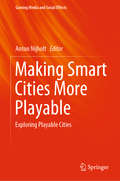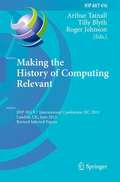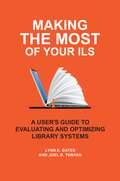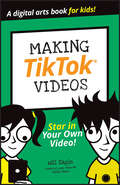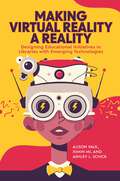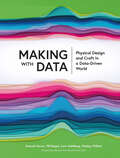- Table View
- List View
Making Sense of Organizational Learning: Putting Theory into Practice
by Cyril KirwanThe ability of a business to engage in real organizational learning and to do so faster and in a more sustainable way than its competitors is being increasingly seen as an essential component of success. In Making Sense of Organizational Learning, Cyril Kirwan examines the wide range of factors necessary to create and sustain organizational learning and knowledge at all levels. At the individual level, the generation of continuous learning opportunities and reflection on experiences are critically important. At the team level, it’s about encouraging collaboration, team learning and the sharing of knowledge. At the organizational level, the emphasis is on building systems to capture and share knowledge and providing strategic leadership for learning. The book shows you how you can best exploit the knowledge that already exists within your organization while at the same time develop the capability of the people that work there. It deals in turn with individual learning; learning with others; learning in organizations; and in particular the role of the HR function and of line managers. Each chapter provides theoretical background and real-world examples. Diagnostic questionnaires, checklists and other tools are also included. Making Sense of Organizational Learning provides an evidence-based argument for the adoption of effective organizational learning policies and practices, and offers a real opportunity to improve performance. Thinking practitioners working in and around learning and development or organization development will find it invaluable, as will those undertaking post-graduate study in HR and related disciplines.
Making Sense of Sensors: End-to-End Algorithms and Infrastructure Design from Wearable-Devices to Data Centers
by Omesh Tickoo Ravi IyerMake the most of the common architectures used for deriving meaningful data from sensors. This book provides you with the tools to understand how sensor data is converted into actionable knowledge and provides tips for in-depth work in this field.Making Sense of Sensors starts with an overview of the general pipeline to extract meaningful data from sensors. It then dives deeper into some commonly used sensors and algorithms designed for knowledge extraction. Practical examples and pointers to more information are used to outline the key aspects of Multimodal recognition. The book concludes with a discussion on relationship extraction, knowledge representation, and management. In today’s world we are surrounded by sensors collecting various types of data about us and our environments. These sensors are the primary input devices for wearable computers, IoT, and other mobile devices. The information is presented in way that allows readers to associate the examples with their daily lives for better understanding of the concepts.What You'll LearnLook at the general architecture for sensor based data Understand how data from common domains such as inertial, visual and audio is processedMaster multi-modal recognition using multiple heterogeneous sensorsTransition from recognition to knowledge through relationship understanding between entitiesLeverage different methods and tools for knowledge representation and managementWho This Book Is ForNew college graduates and professionals interested in acquiring knowledge and the skills to develop innovative solutions around today's sensor-rich devices.
Making Smart Cities More Playable: Exploring Playable Cities (Gaming Media and Social Effects)
by Anton NijholtThis book explores the ways in which the broad range of technologies that make up the smart city infrastructure can be harnessed to incorporate more playfulness into the day-to-day activities that take place within smart cities, making them not only more efficient but also more enjoyable for the people who live and work within their confines. The book addresses various topics that will be of interest to playable cities stakeholders, including the human–computer interaction and game designer communities, computer scientists researching sensor and actuator technology in public spaces, urban designers, and (hopefully) urban policymakers. This is a follow-up to another book on Playable Cities edited by Anton Nijholt and published in 2017 in the same book series, Gaming Media and Social Effects.
Making Social Technologies Work: Leveraging the Power and Managing Perils of Social Technologies in Business (Palgrave Pocket Consultants)
by Ronan GruenbaumEmbracing social technologies at work is not just a blog from the CEO. It is about understanding all the opportunities where social media and technology activities could improve your company from marketing to operations. A practical guide for managers and an informative window into the world of social technologies in business.
Making Supply Chain Management Work: Design, Implementation, Partnerships, Technology, and Profits
by James B. AyersAny supply chain improvement project, even if well conceived, has a good chance of failing, unless the accompanying information technology enables the design. Being prepared, understanding the risks and how to reduce them, will give you the edge you need. Combining a technology focus with practical advice, Making Supply Chain Management Work: Desig
Making Systems Safer: Proceedings of the Eighteenth Safety-Critical Systems Symposium, Bristol, UK, 9-11th February 2010
by Chris Dale Tom AndersonMaking Systems Safer contains the papers presented at the eighteenth annual Safety-critical Systems Symposium, held at Bristol, UK, in February 2010. The Symposium is for engineers, managers and academics in the field of system safety, across all industry sectors, so the papers making up this volume offer a wide-ranging coverage of current safety topics, and a blend of academic research and industrial experience. They include both recent developments in the field and discussion of open issues that will shape future progress. The first paper reflects a tutorial – on Formalization in Safety Cases – held on the first day of the Symposium. The subsequent 15 papers are presented under the headings of the Symposium’s sessions: Perspectives on Systems Safety, Managing Safety-Related Projects, Transport Safety, Safety Standards, Safety Competencies and Safety Methods. The book will be of interest to both academics and practitioners working in the safety-critical systems arena.
Making the Compelling Business Case: Decision-Making Techniques for Successful Business Growth
by W. MessnerProviding the necessary background information and hands-on tools to build compelling business cases, this book will increase the reader's capability to champion new business development ideas, take them to senior management, and facilitate the decision process by understanding the key theories and practices of finance and corporate investments.
Making the e-Business Transformation
by Peter GloorRead this book and you'll not only understand WHY e-Business is vital to the continuing success of your organization but also HOW you can incorporate it into your business.Four key questions are asked within Making the e-Business Transformation: - How do you transform your existing business into an e-business?How do you go about introducing e-business into your Company?- What are the key enabling technologies?- What tools are needed to effectively manage domain and process knowledge?e-Business and e-Commerce is a revolution driven by IT. While computers and computer networks have been around for the last 50 years, it is only in the last five that they have found their way into everyday life. This book shows you how to harness the power of the new technologies to transform your business into an e-business company which will succeed in the e-commerce economy.
Making the History of Computing Relevant: IFIP WG 9.7 International Conference, HC 2013, London, UK, June 17-18, 2013, Revised Selected Papers (IFIP Advances in Information and Communication Technology #416)
by Arthur Tatnall Tilly Blyth Roger JohnsonThis book constitutes the refereed post-proceedings of the IFIP WG 9.7 International Conference on the History of Computing, HC 2013, held in London, UK, in June 2013. The 29 revised full papers presented were carefully reviewed and selected from numerous submissions. The papers cover a wide range of topics related to the history of computing and offer a number of different approaches to making this history relevant. These range from discussion of approaches to describing and analyzing the history through storytelling and education to description of various collections, working installations and reconstruction projects. The papers have been organized in the following topical sections: the importance of storytelling in museums; spotlight on some key collections and their future plans; thoughts on expanding the audience for computing history; spotlight on some research projects; integrating history with computer science education; putting the history of computing into different contexts; celebrating nostalgia for games - and its potential as Trojan horse; the importance and challenges of working installations; and reconstruction stories.
Making the Most of Your ILS: A User's Guide to Evaluating and Optimizing Library Systems
by Lynn E. Gates Joel D. TonyanSystems administrators, librarians, and library staff will learn key principles and methods for securing their ILS and understand how to configure and optimize their library catalog by improving data management practices, streamlining existing workflows, and documenting their system's configuration.The integrated library system (ILS) plays a central role in every library's operations, but is your ILS optimized to ensure maximum productivity? Are you taking advantage of the features added since you implemented it? Walking readers through a wide-ranging ILS review, this book will help you ensure systems are properly configured, produce better documentation, and evaluate staff workflows.The authors-a director of collections and content and a director of user experience-created a comprehensive plan for reviewing an ILS, starting with planning the project and deciding whom to include. They discuss basic ILS security principles, including keeping patron data safe and the importance of reviewing staff permissions. After the basics, the authors go in-depth on reviewing codes and figuring out how different parts of an ILS work together as well as how to review those areas, and they offer ideas on how to stay up-to-date with your ILS, such as where to look for information on issues, updates, and new features. Several methods for analyzing and documenting workflows are also discussed.
Making the Most of Your ILS: A User's Guide to Evaluating and Optimizing Library Systems
by Lynn E. Gates Joel D. TonyanSystems administrators, librarians, and library staff will learn key principles and methods for securing their ILS and understand how to configure and optimize their library catalog by improving data management practices, streamlining existing workflows, and documenting their system's configuration.The integrated library system (ILS) plays a central role in every library's operations, but is your ILS optimized to ensure maximum productivity? Are you taking advantage of the features added since you implemented it? Walking readers through a wide-ranging ILS review, this book will help you ensure systems are properly configured, produce better documentation, and evaluate staff workflows.The authors-a director of collections and content and a director of user experience-created a comprehensive plan for reviewing an ILS, starting with planning the project and deciding whom to include. They discuss basic ILS security principles, including keeping patron data safe and the importance of reviewing staff permissions. After the basics, the authors go in-depth on reviewing codes and figuring out how different parts of an ILS work together as well as how to review those areas, and they offer ideas on how to stay up-to-date with your ILS, such as where to look for information on issues, updates, and new features. Several methods for analyzing and documenting workflows are also discussed.
Making Them Move: Mechanics, Control & Animation of Articulated Figures
by Norman I. Badler Brian A. Barsky David ZeltzerCurrent computer graphics hardware and software make it possible to synthesize near photo-realistic images, but the simulation of natural-looking motion of articulated figures remains a difficultand challenging task. Skillfully rendered animation of humans, animals, and robots can delight and move us, but simulating their realistic motion holds great promise for many other applications as well, including ergonomic engineering design, clinical diagnosis of pathological movements, rehabilitation therapy, and biomechanics.Making Them Move presents the work of leading researchers in computer graphics, psychology, robotics and mechanical engineering who were invited to attend the Workshop on the Mechanics, Control and Animation of ArticulatedFigures held at the MIT Media Lab in April 1989. The book explores biological and robotic motor control, as well as state-of-the-art computergraphics techniques for simulating human and animal figures in a natural and physically realistic manner.
Making TikTok Videos (Dummies Junior)
by Will Eagle Hannah Budke Claire Cohen Andrew Cooper Jordan Elijah Michael Andrew PanturescuCreate videos using the tricks of TikTok stars! Making TikTok Videos reveals the secrets that TikTok celebs and influencers use to make the videos that everyone’s watching. Hilarious clips, the latest dances, instruction videos—whatever you want to do, make sure it shows off the latest TikTok styles. This book shows you how to use whatever you have on hand to record, edit, and upload TikToks. Add music and text, get creative, and start sharing your finished products. With this guide, you’ll get easy instructions on how to make videos that people remember. You also get some tips on how to bring viewers to your account. Use your mobile device to shoot videos with top-notch sound Learn the editing tricks TikTok pros use to create a finished video Set up your TikTok account and set your privacy Keep up with the latest TikTok video stylesWritten especially for the 10-14 age group interested in creating their first TikTok videos, this Dummies Jr. title will help you get plugged into the TikTok universe.
Making TikTok Videos (Dummies Junior)
by Will Eagle Hannah Budke Claire Cohen Andrew Cooper Jordan Elijah Michael Andrew PanturescuCreate videos using the tricks of TikTok stars! Making TikTok Videos reveals the secrets that TikTok celebs and influencers use to make the videos that everyone’s watching. Hilarious clips, the latest dances, instruction videos—whatever you want to do, make sure it shows off the latest TikTok styles. This book shows you how to use whatever you have on hand to record, edit, and upload TikToks. Add music and text, get creative, and start sharing your finished products. With this guide, you’ll get easy instructions on how to make videos that people remember. You also get some tips on how to bring viewers to your account. Use your mobile device to shoot videos with top-notch sound Learn the editing tricks TikTok pros use to create a finished video Set up your TikTok account and set your privacy Keep up with the latest TikTok video stylesWritten especially for the 10-14 age group interested in creating their first TikTok videos, this Dummies Jr. title will help you get plugged into the TikTok universe.
Making Virtual Reality a Reality: Designing Educational Initiatives in Libraries with Emerging Technologies
by Alison Valk Ximin Mi Ashley L. SchickWalks readers through the key components of developing library-led research and programming that leverages emerging technologies with the goal of engaging students and faculty.As educational curricula and research evolve to include advanced technologies, libraries must offer programming with these emerging technologies in mind, including the use of virtual reality (VR) and augmented reality (AR). In this timely guide, Valk, Mi, and Schick present readers with tools for assessing their level of organizational readiness to begin such programs and, more importantly, how to sustain them with limited budgets, expertise, and resources.Building on their own experiences, the authors teach readers how to develop technology-rich classes, assess student projects, and overcome technical hurdles. They spotlight this kind of programming as integral to building strategic partnerships in an educational environment. Readers will learn how to adapt and design programs or initiatives in which the necessary technologies are rapidly changing, not only in higher education institutions, but also in schools. Worksheets and resources assist readers in reflecting on their own work and developing educational programming to suit their organizational needs.
Making Virtual Reality a Reality: Designing Educational Initiatives in Libraries with Emerging Technologies
by Alison Valk Ximin Mi Ashley L. SchickWalks readers through the key components of developing library-led research and programming that leverages emerging technologies with the goal of engaging students and faculty.As educational curricula and research evolve to include advanced technologies, libraries must offer programming with these emerging technologies in mind, including the use of virtual reality (VR) and augmented reality (AR). In this timely guide, Valk, Mi, and Schick present readers with tools for assessing their level of organizational readiness to begin such programs and, more importantly, how to sustain them with limited budgets, expertise, and resources.Building on their own experiences, the authors teach readers how to develop technology-rich classes, assess student projects, and overcome technical hurdles. They spotlight this kind of programming as integral to building strategic partnerships in an educational environment. Readers will learn how to adapt and design programs or initiatives in which the necessary technologies are rapidly changing, not only in higher education institutions, but also in schools. Worksheets and resources assist readers in reflecting on their own work and developing educational programming to suit their organizational needs.
Making with Data: Physical Design and Craft in a Data-Driven World (AK Peters Visualization Series)
by Samuel Huron Till Nagel Lora Oehlberg Wesley WillettHow can we give data physical form? And how might those creations change the ways we experience data and the stories it can tell? Making with Data: Physical Design and Craft in a Data-Driven World provides a snapshot of the diverse practices contemporary creators are using to produce objects, spaces, and experiences imbued with data. Across 25+ beautifully-illustrated chapters, international artists, designers, and scientists each explain the process of creating a specific data-driven piece—illustrating their practice with candid sketches, photos, and design artifacts from their own studios. Featuring influential voices in computer science, data science, graphic design, art, craft, and architecture, Making with Data is accessible and inspiring for enthusiasts and experts alike.
Making with Data: Physical Design and Craft in a Data-Driven World (AK Peters Visualization Series)
by Samuel Huron Till Nagel Lora Oehlberg Wesley WillettHow can we give data physical form? And how might those creations change the ways we experience data and the stories it can tell? Making with Data: Physical Design and Craft in a Data-Driven World provides a snapshot of the diverse practices contemporary creators are using to produce objects, spaces, and experiences imbued with data. Across 25+ beautifully-illustrated chapters, international artists, designers, and scientists each explain the process of creating a specific data-driven piece—illustrating their practice with candid sketches, photos, and design artifacts from their own studios. Featuring influential voices in computer science, data science, graphic design, art, craft, and architecture, Making with Data is accessible and inspiring for enthusiasts and experts alike.
Making Your Data Center Energy Efficient
by Gilbert HeldDetailing powerful methods for reducing the energy costs associated with operating a data center, Making Your Data Center Energy Efficient examines both equipment and building facilities. It reviews the rationale for conserving energy and demonstrates how conservation and careful equipment selection can lead to significant improvements to your bottom line. For those not well-versed in financial or energy terms, the first two chapters provide a detailed discussion of the terms associated with different types of energy, as well as how to compute the return on investment for energy conservation efforts. The text includes tables of monthly expenses associated with operating equipment that will help you convert problems into simple table lookup processes. Among the money-saving topics discussed, it considers: How to minimize the energy consumption of a wide range of devices A little-understood topic that can make a big impact on energy costs-general heating and cooling Techniques required to effectively monitor different types of meters Phantom energy usage and methods for minimizing its cost to your organization Recognizing that most readers may not have direct control over the selection of a furnace or hot water heater, the book provides you with the ability to recognize the efficiencies and inefficiencies of various types of devices, so you can provide input into the decision-making process. From replacing lighting to consolidation and virtualization, it provides you with the well-rounded understanding needed to properly manage all aspects of the energy consumed in your data center.
Making Your Primary School E-safe: Whole School Cyberbullying and E-safety Strategies for Meeting Ofsted Requirements
by Adrienne KatzChildren are using the internet and mobile devices at increasingly younger ages, and it's becoming more and more important to address e-safety in primary schools. This practical book provides guidance on how to teach and promote e-safety and tackle cyberbullying with real-life examples from schools of what works and what schools need to do. The book explains how to set policy and procedures, how to train staff and involve parents, and provides practical strategies and ready-to-use activities for teaching e-safety and meeting Ofsted requirements. Including up-to-the-minute information and advice that includes new technologies, social media sites, and recent school policy trends such as 'Bring Your Own Device', this book provides all of the information that educational professionals need to implement successful whole school e-safety strategies.
Making Your Primary School E-safe: Whole School Cyberbullying and E-safety Strategies for Meeting Ofsted Requirements (PDF)
by Adrienne KatzChildren are using the internet and mobile devices at increasingly younger ages, and it's becoming more and more important to address e-safety in primary schools. This practical book provides guidance on how to teach and promote e-safety and tackle cyberbullying with real-life examples from schools of what works and what schools need to do. The book explains how to set policy and procedures, how to train staff and involve parents, and provides practical strategies and ready-to-use activities for teaching e-safety and meeting Ofsted requirements. Including up-to-the-minute information and advice that includes new technologies, social media sites, and recent school policy trends such as 'Bring Your Own Device', this book provides all of the information that educational professionals need to implement successful whole school e-safety strategies.
Making Your Secondary School E-safe: Whole School Cyberbullying and E-safety Strategies for Meeting Ofsted Requirements (PDF)
by Adrienne KatzCyberbullying, sexting, grooming and other online risks are a daily reality for teenagers so there is an increasing need to effectively teach e-safety in secondary schools. This practical teaching resource for school staff outlines policy and practice and provides ready-to-use activities to help schools meet Ofsted requirements for e-safety.
Makroökonomik und neue Makroökonomik (Heidelberger Taschenbücher #239)
by Bernhard Felderer Stefan HomburgDie hervorragende Aufnahme, die dieses Buch seit seinem erstmaligen Erscheinen im Jahr 1984 in der Fachwelt und bei den Studenten erfahren hat, zeigt, daß es den Autoren gelungen ist, den Leser umfassend in den derzeitigen Stand der makroökonomischen Theorie einzuführen. Das Buch, das auch in englischer Sprache vorliegt, kann als ein Standardwerk bezeichnet werden. Anlaß für seinen Aufbau gab die Vielzahl konkurrierender Theorien auf dem Felde der Makroökonomik; deshalb unterscheidet sich das Buch von den gängigen Darstellungen durch seine doktrinenbezogene Orientierung. Dabei kann zugleich ein Großteil der makroökonomischen Methodik abgehandelt werden und auch wirtschaftspolitische Fragen bekommen ihren Raum. Nach Vermittlung von Grundlagen wird der Leser schrittweise mit der Klassisch-Neoklassischen und der Keynesianischen Theorie bekannt gemacht. Anschließend werden die Portfoliotheorie, der Monetarismus sowie die Theorie der Rationalen Erwartungen abgehandelt; die ebenfalls ausführliche Darstellung der Neokeynesianischen (oder "Ungleichgewichts-") Theorie beschließt den Hauptteil des Buches. Ein mathematischer Anhang vermittelt jene mathematischen Kenntnisse, die für ein Verständnis makroökonomischer Modelle unabdingbar sind und dient zur Verminderung der Anforderungen im Text selbst. Aus den Besprechungen: "Diese zentrale Thematik ist meines Erachtens in keinem deutschsprachigen Lehrbuch bisher so klar und verständlich dargestellt und so stringent ins richtige Licht gesetzt worden. Vielen Studenten bliebe eine Menge wirtschaftstheoretischer Irrungen und Wirrungen erspart, würden sie in dieser Weise an das Thema Makroökonomik herangeführt. In diesem Sinn ist dieses Buch ideal für das Grundstudium". Wolfgang Strassl, Ifo-Studien#1 "Die Autoren bieten eine längst überfällige, übersichtliche Einführung in die verschiedenen makroökonomischen Schulen, die sich in den vergangenen 200 Jahren entwickelt haben und früher oder später jedem Studenten im VWL-Studium begegnen". das wirtschaftsstudium#2


